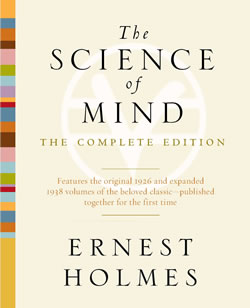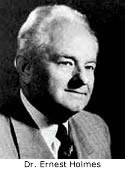| |
SEVEN QUESTIONS ON THE SCIENCE OF MIND:
THE COMPLETE EDITION
—Joel Fotinos
 On January 6, 2011, Tarcher/Penguin published The Science of Mind: The Complete Edition by Ernest Holmes, founder of Religious Science, and the “textbook” used in the hundreds of Centers for Spiritual Living around the country and the world. On January 6, 2011, Tarcher/Penguin published The Science of Mind: The Complete Edition by Ernest Holmes, founder of Religious Science, and the “textbook” used in the hundreds of Centers for Spiritual Living around the country and the world.
Tarcher/Penguin publisher Joel Fotinos gives us an overview of what this new edition contains, and what readers might expect.
What makes this version of The Science of Mind more complete than any other version on the market?
Most people don’t realize that Ernest Holmes actually published two different editions of The Science of Mind in his lifetime. He published the original edition in 1926, and then expanded, enlarged, and substantially changed it in the “updated” edition, which was published in 1938. For the first time ever, both editions are now being published in one volume.
Why did you decide to publish both editions together?
Both the 1926 and 1938 editions contain information that will be of interest to anyone interested in the Science of Mind philosophy, and when read together, it’s interesting to see how Ernest Holmes expanded his philosophy in the later edition.
Also, we decided to publish both editions together to help educate the readers that there are two editions. Most of the spiritual centers that are based on the Ernest Holmes philosophy use the “official” 1938 edition. Their classes are taught from that later edition, the curriculum is from that later edition, and the church bookstores stock that later edition.
However, a few years ago, the earlier 1926 edition became “public domain,” meaning that any publisher could publish it without paying royalties to the author or author’s estate (which in this case is the United Centers for Spiritual Living, or UCSL). Unfortunately, this meant that UCSL didn’t have control over those “public domain” editions being printed. Many “print-on-demand” publishers began publishing the 1926 edition of The Science of Mind in low-quality editions that were priced cheaper than the official 1938 edition. People would purchase a cheaper edition from Amazon or Barnes & Noble online without knowing that it wasn’t the official 1938 edition used in the centers where they were attending and taking classes, or that no royalties were being paid to UCSL for them.
The vast majority of people who ordered these cheaper, print-on-demand copies of The Science of Mind on-line were wanting to the official 1938 edition, but since they didn’t know there were two editions with the same title, they were taken aback when they would receive something very different from the official version used in their church or classes. We received many letters from people who were worried that the 1926 wasn’t really written by Ernest Holmes, or they were concerned that the two editions were confusing readers who really wanted the 1938 edition.
Publishing both editions in one volume alerts readers that there are two editions, and that both are worth reading. Plus, this is the only edition that contains both versions, and UCSL receives royalties for this edition, which also helps to bring this message out to more people.
How are the 1926 and 1938 editions different? Do students of Ernest Holmes’s philosophy need to read both editions?
Both editions of The Science of Mind contain the same general teaching that Religious Science is based on. However, Ernest Holmes included different information in each edition. The 1926 edition contains material on topics such as psychic phenomena, sex, and spiritualism, all of which was removed for the later edition. Also, the 1926 was written as a series of lessons, while the later edition was organized more as a full textbook.
While both editions have some striking differences in content and organization, both editions are worth reading. They take readers on a spiritual journey, and when reading both editions back-to-back, readers can see how Ernest Holmes grew in the reach and understanding of his philosophy.
What new material can readers find in the The Science of Mind: The Complete Edition?
In addition to the 1926 and 1938 editions of The Science of Mind, we’ve included some very special additions, to add more context and information. Dr. Kathy Hearn, who is the Community Spiritual Leader for UCSL, wrote an insightful and important foreword, which helps readers to understand how reading both editions can bring insight into their lives. And Rev. Jesse Jennings, who is an expert in New Thought and Science of Mind history, wrote two pieces for this edition. The first is a new introduction, which gives the historical background of the two editions of The Science of Mind. Second, he wrote a new, brief biography of Ernest Holmes, which will give new readers a good overview of the life of this great man, from whom we continue to learn.
Why did Holmes revise The Science of Mind?
 During the nine years between the two editions, Ernest Holmes continued to teach, to learn, and to experience the philosophy. When it came to time to reprint the work, he wanted to bring all that he had learned in those nine years to the new edition, knowing it was the cornerstone of his teaching. He worked with Maude Allison Lathem, who for many years was the editor of Science of Mind magazine, to bring the principles of his teaching in the clearest, most powerful edition. During the nine years between the two editions, Ernest Holmes continued to teach, to learn, and to experience the philosophy. When it came to time to reprint the work, he wanted to bring all that he had learned in those nine years to the new edition, knowing it was the cornerstone of his teaching. He worked with Maude Allison Lathem, who for many years was the editor of Science of Mind magazine, to bring the principles of his teaching in the clearest, most powerful edition.
Why has the message of The Science of Mind by Ernest Holmes continued to resonate with readers?
Reading The Science of Mind: The Complete Edition, I was reminded again and again at his brilliance. Ernest Holmes was a genius at distilling the complex teachings of philosophy, religion, science, psychology, art, and more, all into principles and ideas that could benefit people directly. He made sure that all the information he taught was practical and would help people wherever they were in life. It was his clarity and depth of knowledge that have inspired readers and students all these years.
Are there any more plans to re-publish some of Ernest Holmes’s books that have gone out of print?
Tarcher/Penguin recently republished Ernest Holmes classic work, A New Design for Living, which is used in classes around the country. Also, many of his earlier works are up for republication, including It’s Up to You, Think Your Troubles Away, Living Without Fear, Discover A Richer Life, Questions & Answers on the Science of Mind, and others. Each of these republications will be re-typeset, so that the print is easier to read, and they each will have new covers. We take great pride in publishing Ernest Holmes’s books, and we do so with care and attention to detail. It’s our honor to actively publish these works, and we know each title by Ernest Holmes that we publish will help many people around the globe live better and freer lives. What could be better than that?
—Joel Fotinos |
|

 On January 6, 2011, Tarcher/Penguin published The Science of Mind: The Complete Edition by Ernest Holmes, founder of Religious Science, and the “textbook” used in the hundreds of Centers for Spiritual Living around the country and the world.
On January 6, 2011, Tarcher/Penguin published The Science of Mind: The Complete Edition by Ernest Holmes, founder of Religious Science, and the “textbook” used in the hundreds of Centers for Spiritual Living around the country and the world. During the nine years between the two editions, Ernest Holmes continued to teach, to learn, and to experience the philosophy. When it came to time to reprint the work, he wanted to bring all that he had learned in those nine years to the new edition, knowing it was the cornerstone of his teaching. He worked with Maude Allison Lathem, who for many years was the editor of Science of Mind magazine, to bring the principles of his teaching in the clearest, most powerful edition.
During the nine years between the two editions, Ernest Holmes continued to teach, to learn, and to experience the philosophy. When it came to time to reprint the work, he wanted to bring all that he had learned in those nine years to the new edition, knowing it was the cornerstone of his teaching. He worked with Maude Allison Lathem, who for many years was the editor of Science of Mind magazine, to bring the principles of his teaching in the clearest, most powerful edition.